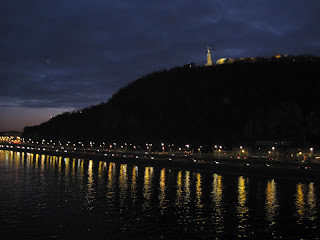 |
| my fur coat on the hanger |
Now, these coats come in all shapes and sizes. There are full-length mink, beaver, ermine; there are fur-trimmed wool coats, half-length rabbit or raccoon, or simple stoles to be worn at the opera - in the balcony. Or front row center. The choices are endless, even if the bank account isn't. For those of you interested, a floor-length mink costs about €10,000, and was most likely caught and bludgeoned to death in Siberia. The killing of animals for the fur trade is illegal in Austria, but the selling of furs is perfectly legit, provided the animals died and were sewn together in a different country. And the demand is high, obviously.
I have my own fur-trimmed winter coat, and, since I packed it and brought it all the way from Wisconsin, I'm glad this year I've gotten to wear it quite a bit, what with the extremely cold month of February we've been having in Europe. And I honestly don't get the excuse to wear it in the USA I do here; besides, it's such a beautiful coat.
At this point, many of my loyal readers (who?) might be scratching their head right now. Really? you could be thinking. Vanessa? The vegetarian? Owning a fur? That doesn't sound right. Why would she have anything to do with fur? Let me tell you. It's an interesting story, which is why I thought it would make an interesting blog post.
 |
| in front of elevator in my building |
It all started my freshman year at Lawrence. The drama department was having a costume sale in the Voyager room across from the old Grill in the Union. There wasn't much all that exciting up for grabs, except this coat, which was sitting humbly (yet provocatively) on a hanger. Price? $10. I realized then that it would become mine.
I have no idea why no one else wanted it. Perhaps it was destined for me, perhaps I was the first one to get down to the sale that day. Perhaps all the other hippy-vegan darlings of my alma mater were too principled to lay down ten bucks for something that was once an animal. It doesn't really matter. As soon as I laid down my ten dollar bill, I secured the coat against my person and dashed back to my dorm. I did a little dance in the stairwell before getting to my room and opening the door to my roommate, who was on Facebook when she should have been studying for art history.
To me, it was obviously vintage - at that point, I didn't quite know how vintage - and by that sheer fact made even better. Being vintage, whatever animal it had been was obviously murdered before my lifetime, and therefore pardonable, in my code of ethics. I've been wearing vintage outfits, and specifically, vintage coats (my great-grandmother's until it fell apart, and then ones from second-hand shops), since high school.
 |
| fur cuff - the other side is disintegrating :( |
Noticing how badly the fur is falling apart prompted me to do a Google search on it, to see if I could figure out a few more things about it. I've thought about taking it to a furrier in Vienna to have it appraised, but since it's no longer in the best condition, and the furrier might chide me about not taking good care of it, I balked. That's probably the only way to know for certain what kind of fur it is, however.
The only clue the coat itself has given me is the tag in the lining: THE PETTIBONE & PEABODY CO. it reads. I asked my dad about it, since he grew up in Appleton and he remembers there being such a store when he was a little boy. His mother shopped there. It is there no longer, much like many of the old department stores of yesteryear, being bought up or run out of business by chain stores and the like. Amazon.com, perhaps. Anyway, my Google search came up with some very interesting results, particularly this blog and this souvenir book sold by the company before its demise. It appears that Pettibone and Peabody was one of the oldest retailers in the state of Wisconsin, and opened in 1865. It was Appleton's premier retailer until it H.C. Prange Co. (now Younker's) bought it out in 1946. Thus, for the tag to still read "Pettibone & Peabody Co." it must be at least 65 years old, any may be even older. No wonder the fur is disintegrating, right?
Regardless, I'm pretty tickled about this. Not only is it super vintage, it's my favorite era - I was guessing realistically that it was from the 1960s or later (and donated post mortem by some Lawrence aluma/us) - but in my heart of hearts, I knew the style screamed 1940s - and I was totally right. Maybe even 1930s, but I won't get ahead of myself.
For those of you unconvinced, please please follow my links! And this one while you're at it. And then if you're still not convince, that's not my problem. 'Cause haters gonna hate.




















